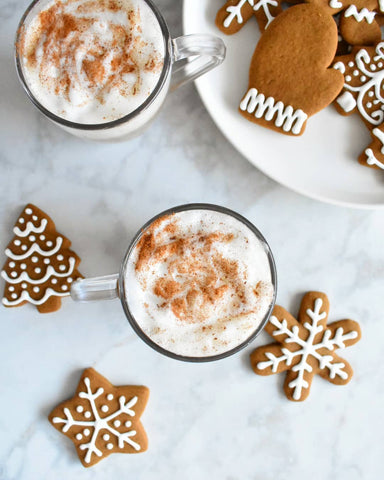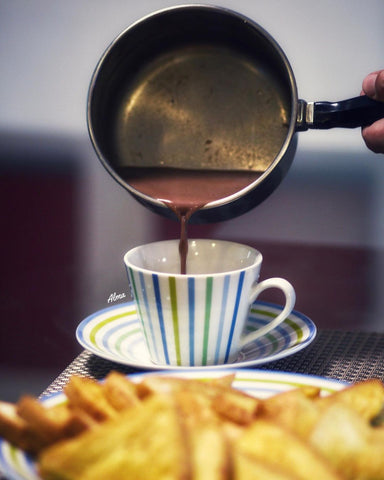It's that time of year again! Everyone has their own traditions for the holiday season, including ceremonies, food, and events. Thankfully, there are also numerous beverages to celebrate with, both espresso and non-caffeinated, that you can create from your home. With these festive traditions, some familiar and some foreign, you won't run out of options to celebrate the holidays from your kitchen.
Eggnog
Canada/United States
This drink is able to be made both alcoholic and non-alcoholic, and is a staple of the holidays in many countries around the world. Originally from the United Kingdom, the drink has become more popular in Canada and the United States for the past few centuries. In Great Britain, eggnog was first drank by aristocrats, because the ingredients to make it were expensive. It didn't get common in the States until after the Revolutionary War, and primarily became associated with the holiday season.
To make this holiday tradition at home, the traditional recipe requires mixing together sugar and egg yolks. They are then added to milk, cream, and nutmeg for heating. Once the mixture is heated thoroughly, chill it to be served cold. You can add cinnamon and whipped cream at the end for extra flavor and of course, some alcohol, such as brandy, rum or whiskey.
*If you're craving an espresso shot, you can add one (or two!) to this classic drink recipe. You're ready for the day, while remaining in the holiday spirit.
Gingerbread Latte
Canada/England/United States
While gingerbread has been a holiday staple for centuries (it was considered sacred, and was only allowed to be made by the public during Christmas and Easter), the latte version of this spice gained popularity after Starbucks released the gingerbread latte in 2000. It hasn't been sold at Starbucks for the holiday season for the past two winters, but the recipe has cemented itself in being an annual tradition.
Ginger, cinnamon, and nutmeg spices are mixed with hot milk, and then added to espresso or coffee, to bring you this holiday concoction that will taste like you're drinking a gingerbread cookie.
Instagram: herbsandflour
Poppy Seed Milk
Lithuania
This drink is primarily celebrated around Christmastime in Lithuania, and is a staple of the holidays. It can be consumed either as a drink or soup. It is typically used in the Twelve-dish Christmas Eve supper in Lithuania, which memorializes Jesus' twelve disciples. While poppy seeds are more specific to Lithuania, this celebration is also held in Ukraine and Poland.
The poppy seeds need to be soaked in hot water until they become soft. The seeds are then crushed several times in order to get a suitable concentrate of poppy seed milk. After the hot liquid is diluted with cold water and the seeds are crushed, the milk is ready to drink. Sugar or honey can also be added for additional flavor.
*If you want to be caffeinated, this particular beverage isn't what you're looking for. It's actually been suggested as a sleep aid!
Tablea Tsokolate
The Philippines
This is a Filipino version of hot chocolate, typically served at breakfast with bread to dip. During the Christmas season, this drink is very popular. Christmas is so big in The Philippines, that the holiday pops up as early as September, and lasts until Three Kings Day in January.
In order to make "tsokolate," cacao tablets are dissolved in hot water and then blended for consistency. It can be sweetened with sugar and a splash of milk, if desired.
Instagram: @alma.o.go
Coquito
Puerto Rico
Coquito, or "little coconut" in English, is a traditional Christmas drink that originated from Puerto Rico. However, its origins are controversial. Some believe the Spanish brought it to the Caribbean during the colonial period in Puerto Rico, while others believe there is no way to know who was the first person to make the recipe. It is sometimes referred to as "Puerto Rican eggnog," and has many variations, depending on who is making it.
It is primarily made by blending together coconut rum, condensed milk, and an optional egg yolk together. Vanilla can also be added for additional taste. The drink is normally served chilled, but it can be prepared hot over a stove. Don't forget to top it with cinnamon and nutmeg spices! If you're an eggnog addict during the holiday season, you're going to want to try this delicious Puerto Rican version.
Instagram: @honeyedsundays
Sujeonggwa
South Korea
Christmas wouldn't be complete without a traditional drink from our native country. This is a popular cinnamon punch, typically served during the holiday season in South Korea. It is even known to help with the digestion process, and is often served in Korean BBQ restaurants to consume after the heavy meal.
Cinnamon and ginger are first brewed in hot water, and then drained. The remaining boiled water from the spices are then boiled a second time with sugar. Honey can also be added for additional flavor. The drink's signature is dried persimmons, which are mixed in at the end to soak in the beverage. Though boiled, it is usually chilled to serve ice cold, which is what you normally see in restaurants. This is a unique recipe that can be enjoyed once your festivities are over and you can't eat another bite of holiday food.
Salep
Turkey
Salep is a flour made from orchids, which can be consumed both as a beverage or dessert. This is especially common during the holidays in Turkey, and it dates back to the 18th century. The drink originated in the Ottoman Empire and spread to Europe, before coffee and tea grew in popularity around the world. The recipe was particularly popular in England, referred to as "saloop." The ingredients were changed over time, such as using roots of sassafras trees instead.
It used to be made with hot water, but nowadays, it is made with hot milk. Salep flour is mixed with sugar and milk until the sugar dissolves. The mixture is then heated until it is thickened. It is typically garnished with spices at the end of the process, such as cinnamon. This drink is so popular in Middle Eastern culture, that certain species of orchid plants are facing extinction in Turkey and Iran.
Instagram: kentteekolojikhayat
Peppermint Hot Chocolate
Worldwide
It wouldn't be the holidays without that sweet taste of peppermint in your beverage. This is a recipe that can be found all over the world, but is particularly common in Western culture. The peppermint mocha (or the espresso version of this drink, for those wanting coffee), was launched at Starbucks in 2002 for the holiday season, and became one of the most successful holiday beverages in the company's history.
To create the hot chocolate mixture, cream, milk, sugar and salt are heated together. The chocolate gets thrown in once the mixture begins to steam and peppermint extract is added for flavor. Once the chocolate has sufficiently melted, it is ready to enjoy. If you have some candy canes lying around, this could be a festive way to celebrate with them.
Salted Caramel Mocha
Canada/United States
If we've learned anything, it's that Starbucks knows how to create recipes for us to crave during the holidays. Fortunately, this recipe is easy to make at home for caffeine and sweet lovers.
It can be easily recreated in your kitchen by heating caramel sauce, cocoa powder, and milk together. Coffee or espresso is then added once the ingredients are heated and mixed well. Normally, the drink is topped with whipped cream and extra caramel drizzle. For the saltiness, you can add a bit of sea salt on top of the whipped cream.
Instagram: @khtsradio
Toffee Nut Latte
Worldwide
This holiday recipe has found its place on menus in coffee shops all around the world, including South Korea. The recipe is simple to make at home, so you can make your kitchen smell like toasted nuts and roasted coffee shop espresso.
All the drink requires is hot milk, toffee nut syrup, and your coffee of choice. If you want to get creative and treat yourself, you can even add some caramel drizzle and whipped cream on top, and some toffee nut sprinkles, which can be purchased at the store or online.
Instagram: @plaza.insani.mutfakta
There's many creative ways to celebrate the holidays and explore various cultures without leaving your kitchen. These are just a few recipes that you can experiment with to spice up your holidays this year.











Leave a comment